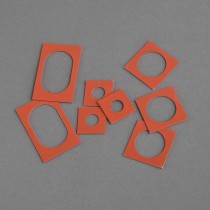FastWells™ Reagent Barriers
FastWells™ are sticky, flexible silicone gaskets that form hydrophobic reagent barriers around specimens without messy adhesives or special slides. Gaskets may be stacked to increase depth and volume.
FastWell™ Reagent Barriers provide rapid isolation of cells and tissues on slides or coverslips for antibody incubations. The barriers remain sealed during agitated washing steps, preventing reagents from spilling when shaken or rocked. FastWells™ peel off quickly and cleanly, leaving no residue to interfere with specimen cover-slipping. They can be washed, autoclaved and reused. The barriers can also be sealed to form incubation chambers using flexible HybriSlip™ covers.
Applications
- Microscopy
- Fluorescence In situ Hybridization (FISH)
- Single-molecule fluorescence analysis
- Immunohistochemistry

Products
FW9-FastWells 9mm Dia. X 1.0mm Depth - 18 X 18mm OD - 50 PACK
| Id | 664112 |
| Title | FW9-FastWells 9mm Dia. X 1.0mm Depth - 18 X 18mm OD - 50 PACK |
| Substrate | |
| Format | |
| Mean Diameter | |
| Color Labeling | |
| Surface Modifications | |
| Solids Content | |
| Product Dimensions | |
| Packaging | |
| Packaging Volume | |
| Package Weight | |
| Dimensions | |
| Hts Code | |
| Pads Wells | |
| Pad Size | |
| Well Format | |
| Product Thickness | |
| Description | FastWells Reagent Barriers are sticky, flexible silicone gaskets form hydrophobic reagent barriers around specimens without messy adhesives or special slides. Stackable and reusable. |
| Image |
References
- Yokomizo, T., & Dzierzak, E. (2010). Three-dimensional cartography of hematopoietic clusters in the vasculature of whole mouse embryos. Development, 137(21), 3651–3661.
- Yokomizo, T., Yamada-Inagawa, T., Yzaguirre, A. D., Chen, M. J., Speck, N. A., & Dzierzak, E. (2012). Whole-mount three-dimensional imaging of internally localized immunostained cells within mouse embryos.Nature Protocols, 7(3), 421–431.
- Wang, Y.-H., Collins, A., Guo, L., Smith-Dupont, K. B., Gai, F., Svitkina, T., & Janmey, P. A. (2012). Divalent Cation-Induced Cluster Formation by Polyphosphoinositides in Model Membranes. Journal of the American Chemical Society, 134(7), 3387–3395.
